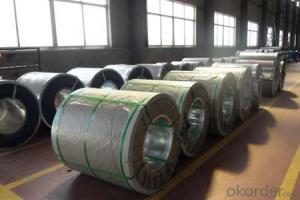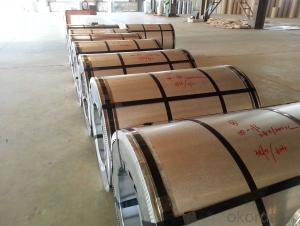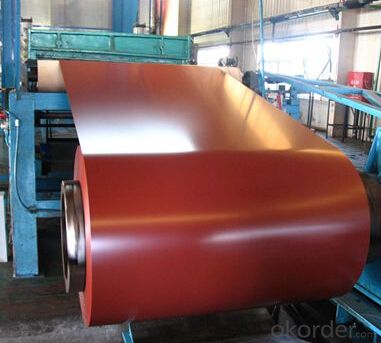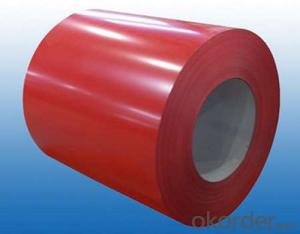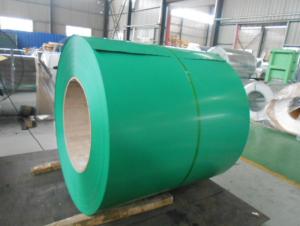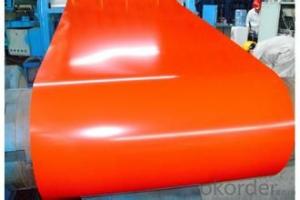PPGI Prepainted steel coil from China galvanized
- Loading Port:
- Tianjin
- Payment Terms:
- TT OR LC
- Min Order Qty:
- 50 m.t.
- Supply Capability:
- 10000 m.t./month
OKorder Service Pledge
OKorder Financial Service
You Might Also Like
PREPAINTED GALVANIZED STEEL COILS
ZINC COATING:60g/m2 (-/+10g/m2)
COLOR: ACCORDING TO COLOR SAMPLE.
TOP COATING:5+13 MICRON, BACK COATING:5-7 MICRON;
COIL WEIGHT:3-5 ton
STANDARD:JIS G 3312
STEEL GRADE:CGCC
COIL ID:508mm
1.THICKNESS:-0.02/+0.02mm; WIDTH:0/5mm.ZINC COATING:+/-10g/m2;
2.TOLERANCE:+/-10% WITH QUANTITIES AND AMOUNT.
3.PACKAGE:FULL PACKED WITH ANTI-DAMP PAPER,IRON SHEET OUTSIDE.
4.SHIPMENT: GOODS WILL BE DELIVERED WITHIN 20 DAYS AFTER RECEIVING ADVANCE PAYMENT
5.TERMS OF PAYMENT: 20% TT IN ADVANCE,80% AGAINST COPY OF B/L. OR LC AT SIGHT
6.THIRD PARTY INSPECTION: SGS, INTERTEK,COTECNA ,BV. ANY EXPENSE ON INSPECTION(SUCH AS SGS,INTERTEK...) SHALL BE ON BUYER'S ACCOUNT.


- Q: What are the typical tolerances for steel coils?
- The typical tolerances for steel coils depend on various factors such as the specific grade of steel, the manufacturing process, and the intended application. However, some common tolerances for steel coils include thickness tolerances of +/- 0.005 to 0.010 inches, width tolerances of +/- 0.020 to 0.050 inches, and length tolerances of +/- 0.125 to 0.250 inches. These tolerances ensure that the steel coils meet the required specifications and can be used efficiently in different industries such as automotive, construction, and manufacturing.
- Q: How are steel coils used in the manufacturing of construction formwork?
- Steel coils are used in the manufacturing of construction formwork to create the framework and support structures needed for pouring concrete. The steel coils are typically shaped and cut into various sections to form the desired shape and size of the formwork. These coils provide strength, durability, and stability, ensuring that the formwork can withstand the weight and pressure of the concrete during the construction process.
- Q: How are steel coils used in the manufacturing of agricultural equipment?
- Steel coils are used in the manufacturing of agricultural equipment as they serve as a raw material for various components such as frames, chassis, and structural supports. These coils are shaped, cut, and welded to form the necessary parts, providing strength, durability, and stability to the equipment.
- Q: What is the difference between carbon steel and spring steel?? And which is the better one to make swords with??
- Neuropathy Solution can help people of neuropathy to eliminate all the outward indications of this problem including : tingling, prickling feeling , numbness of the area round the affected nerves, quick problems , sharp as well as using feeling in the nerves. Dr. Randall Labrum, the author of this unique guide feels that you will eliminate most of the outward indications of neuropathy and eliminate that dangerous illness permanently.
- Q: What are the advantages of using steel coils in construction?
- There are several advantages of using steel coils in construction. Firstly, steel coils are extremely strong and durable. They have a high tensile strength, which means they can withstand heavy loads and resist deformation. This makes them ideal for structural applications in construction, such as beams, columns, and frames. Secondly, steel coils are highly versatile. They can be easily shaped and molded into various forms, allowing for flexibility in design and construction. Steel coils can be rolled, bent, cut, and welded to meet specific project requirements. This adaptability makes them suitable for a wide range of construction applications. Another advantage of using steel coils in construction is their resistance to corrosion. Steel coils are often coated with protective coatings, such as galvanized or stainless steel, to prevent rusting and corrosion. This ensures that the structural integrity of the building remains intact over time, even in harsh environmental conditions. Furthermore, steel coils offer excellent fire resistance. Unlike other construction materials like wood, steel does not burn or contribute to the spread of fire. This makes it a safer choice for construction, particularly in high-rise buildings or areas prone to fire hazards. Lastly, steel coils are cost-effective. While the initial cost of using steel coils may be higher compared to some other materials, their longevity and low maintenance requirements make them a cost-efficient option in the long run. Steel coils have a long lifespan and require minimal repairs or replacements, resulting in reduced maintenance costs and increased overall value. In conclusion, the advantages of using steel coils in construction include their strength, versatility, corrosion resistance, fire resistance, and cost-effectiveness. These qualities make steel coils an excellent choice for various construction applications, contributing to the durability and safety of buildings.
- Q: How are steel coils loaded onto trucks or containers?
- Steel coils are typically loaded onto trucks or containers using specialized equipment such as cranes, forklifts, or coil trailers. The coils are lifted and secured onto the truck or container using straps, chains, or clamps to ensure safe transportation.
- Q: How are steel coils used in the production of automobile frames?
- Steel coils are used in the production of automobile frames as they are unrolled and shaped into the desired form to create the structural framework that provides strength and rigidity to the vehicle.
- Q: Aluminum alloy rolling doors and color steel shutter door that good
- The material and structure design Aluminum Alloy rolling shutter door out of the ordinary, can effectively prevent glare and ultraviolet radiation, sunlight greenhouse effect on indoor has completely solved, applicable to all kinds of changes in climate and weather, has a long-term protective effect on indoor environment, tests show that the shutter doors and windows to keep out sunshine rate to 100%, the the rate can reach more than 95% block temperature.
- Q: Can steel coils be stretched?
- Yes, steel coils can be stretched.
- Q: How are steel coils used in the production of fireproof doors?
- Steel coils are used in the production of fireproof doors as they serve as the core material for the door's structure, providing strength and durability. The coils are typically shaped, cut, and molded into the desired door shape, then combined with fire-resistant materials such as gypsum or mineral wool to enhance the door's fire resistance.
Send your message to us
PPGI Prepainted steel coil from China galvanized
- Loading Port:
- Tianjin
- Payment Terms:
- TT OR LC
- Min Order Qty:
- 50 m.t.
- Supply Capability:
- 10000 m.t./month
OKorder Service Pledge
OKorder Financial Service
Similar products
Hot products
Hot Searches
Related keywords

